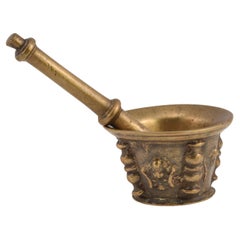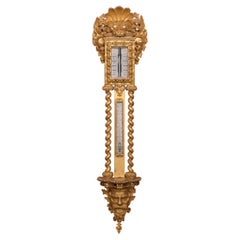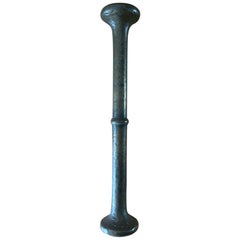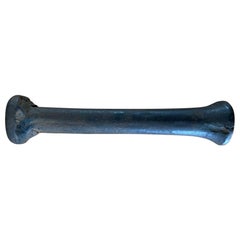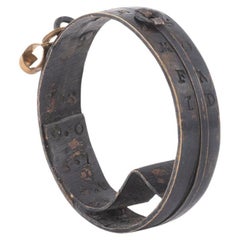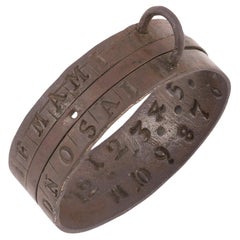European Scientific Instruments
16
to
3
8
7
16
16
16
117
113
43
43
38
22
21
16
16
15
8
8
7
5
4
4
2
1
9
6
1
12
5
5
2
2
16
3
3
2
2
1
1
1
Style: Baroque
Place of Origin: European
Mortar with pestle. Bronze. Spanish school, 17th century.
Located in Madrid, ES
Mortar with pestle. Bronze. Spanish school, 17th century.
Bronze mortar with a convex mouth, a raised base facing outwards and a cylindrical body decorated on the outside with relie...
Category
17th Century Baroque Antique European Scientific Instruments
Materials
Bronze
Alnmått (Cubit measure) in iron with gilded details. Baroque, dated 1731
Located in Knivsta, SE
Swedish Alnmått (Cubit measure) in iron with gilded details. Baroque, dated 1731. Provenance: Baron Carl Emanuel Cederström, great collector during the mid-19th Century in Sweden.
W...
Category
1730s Baroque Antique European Scientific Instruments
Materials
Iron
Baroque Style Venetian Gilt Carved Barometer by Palladio
By Palladio
Located in Rio Vista, CA
Gorgeous intentionally aged Venetian barometer made in the baroque taste by Italian artisans Palladio. The diamond shaped frame is painted and embellished with gilt scrollwork and ro...
Category
20th Century Baroque European Scientific Instruments
Materials
Metal
19th Century Irish Giltwood Barometer in the Baroque Style
Located in Dublin, IE
A fascinating Irish giltwood barometer in the baroque style. The large stick barometer features a large carved giltwood frame with a shell motif. The dial having the original twin Ve...
Category
19th Century Baroque Antique European Scientific Instruments
Materials
Giltwood
18th Century Italian Bronze Pestle for a Mortar, 9 Inches Long
Located in Stamford, CT
If you've got the mortar, I have the pestle! There are so many mortars out there, and so few pestles. It's nice to have both. Here is your opportunity to marry this large scale pestl...
Category
18th Century Baroque Antique European Scientific Instruments
Materials
Bronze
17th Century Norther European Wrought Iron Pestle, 8.5 Inches
Located in Stamford, CT
Unusual wrought iron pestle, most are bronze like most mortars. This one is at least 17th century, quite possibly dating to the Gothic period. I have owned two iron mortars in my ti...
Category
Early 17th Century Baroque Antique European Scientific Instruments
Materials
Wrought Iron
Bronze Mortar with Pestle, Spain, 17th Century
Located in Madrid, ES
Mortar with hand. Bronze. XVII century.
Mortar with a circular base, cylindrical body and slightly outwardly flared mouth, decorated with a series of smooth horizontal moldings arranged both in the lower and upper areas and with simple vertical elements (which still maintain slight balustraded shapes) derived from of the ribs that these specimens used to have in the medieval Spanish...
Category
17th Century Baroque Antique European Scientific Instruments
Materials
Bronze, Other
Mechanical Equatorial Sundial, Johann Michael Bergauer, Ante 1745
By Johann Michael Bergauer
Located in Milano, IT
Johann Michael Bergauer (Simonsfeld, 1676 - Innsbruck, 1745 circa)
Mechanical equatorial sundial
Signed: Michael Bergauer Insprugg? Innsbruck?
Ante 1745
Gilded and silvered brass; glass.
Measures: closed 1.29 x 3.50 x 4.92 in (33 x 89 x 125 mm); open 5.19 x 3.50 x 3.81 in (132 x 89 x 97 mm).
Weight: the sundial 0.49 lb (224 g); the case 0, 20 lb (95 g)
Original wooden case covered in brown leather.
State of conservation: very good. It has some signs of use. The spring that allowed for the two parts of the instrument to remain open is missing (absent even in the comparative specimens kept in museums).
The sundial is composed of two overlapping plates hinged together on the north edge.
The base plate is octagonal and is supported by three turned legs. The upper face is gilded and a compass with a magnetic variation index has been inserted. The rest of the surface is occupied by a rich decoration of engraved scrolls, centered around the inscription “Michael Bergauer Insprugg”. A foldable oval support with a plumb-bob is attached with a hinge on the southern edge. On the reverse of the base plate a table of the latitudes of some European cities (expanded with the vertical writing “Meiland 40” on the edge and “Rome” deleted) and of Jerusalem has been engraved. A Cam marked for 0 °-70 ° is applied near the northern edge. This can be adjusted to change the inclination of the upper plate according to the latitude; originally a spring, now lost, made it possible to keep the two plates of the clock open.
The second plate is round, has a toothed edge and measures 3.26 in (83 mm) in diameter: it is slightly smaller than the octagonal base which it rests upon and overlaps when the instrument is closed.
The recto is gilded and there are three concentric graduated circles engraved on it:
- the outermost is the equatorial hour dial, numbered I-XII, I-XII;
- the second-one is that of days 1-30 of the lunar month and has “Aetas lunae” engraved on it;
- the third, silvered, is a subsidiary hour dial, with double numbering 1-12; originally it could have been rotated.
The engravings of the first two circles are enameled in red.
In the center - on the polar axis - there is an alidade, at the end of which is associated the silvered minute dial. This, in turn, is welded, perpendicularly, to a small disc, also silvered, with a triangular gnomon. The plate, alidade and minute dial are connected to each other by toothed mechanisms.
Below is the procedure for measuring the time:
1) Adjust the Cam under the base of the clock, based on the latitude of your location;
2) Place the watch on a flat surface using the plumb-bob and with the side closest to the compass facing south;
3) Keeping the instrument still, manually rotate the alidade until the shadow cast by the triangular gnomon on the small silvered disc falls on the line marked below it;
4) The hour and minutes can therefore be read on the hour and minute dials set on the alidade respectively.
Johann Michael Bergauer, who sometimes only signs his works as Michael Bergauer, was born in Simonsfeld, north of Vienna. His apprenticeship as a watchmaker took place in Landshut and he probably worked as a laborer in Augsburg before becoming a watchmaker at the court of Karl Philipp von der Pfalz in Innsbruck in 1708. In the following years, his repeated attempts to obtain Innsbruck citizenship are documented and, in 1721, he is listed as a resident. In 1724 he was admitted to the guild of watchmakers, with which however he had continuous problems. In 1732 he presented a "masterpiece". This is the last reference to his business; he must have died before or in 1745 because in that year his widow appealed to the City Council.
The mechanical sundial...
Category
1730s Baroque Antique European Scientific Instruments
Materials
Brass
Hughes Telegraph Set Built by Siemens & Halske 19th Century
By Europa Antiques
Located in Madrid, ES
Hughes typewriting telegraph .A Printing Telegraph Set built by Siemens & Halske .This teletyper was invented by David Edward Hughes in 1856.Good condicion overall.Similar telegraph ...
Category
19th Century Baroque Antique European Scientific Instruments
Materials
Wood
London Mid-19th Century Vanity Kit Set Sterling Silver
Located in Brescia, IT
Not easy to find this original box, with this kit set composed of 8 pieces for nail manicure. A piece to collect or to add in a wunderkammer.
In sterling silver, all marked.
With ce...
Category
Mid-19th Century Baroque Antique European Scientific Instruments
Materials
Crystal, Sterling Silver
19th Century, J. Florenz Wien Chrome Steel Austrian Balance, 11 Brass Weights
Located in Vigonza, Padua
19th century, chrome steel Austrian balance, by J. Florenz Wien, 11 brass weights, 5 kg.
This precious antique table scale was from the famous Caffè Florian in Venice
Caffè Florian is a historic café in the city of Venice, located under the arcades of the Procuratie Nuove in Piazza San Marco.
It is the oldest Italian coffee and the oldest coffee in the world. It was inaugurated on December 29, 1720 by Floriano Francesconi with the name of Alla Venezia Trionfante, but immediately the Venetians simply said “andemo da Florian-let's go to Florian”, from the name of the owner in the Venetian dialect. Since then it has continued its daily coffee business uninterruptedly to the present day, becoming a favorite destination for Venetians, Italians and foreigners. Floriano Francesconi inspired the character of Ridolfo in Carlo Goldoni's coffee shop.
Giacomo Casanova courted the ladies there and Carlo Goldoni entered as a boy. Famous people such as Gasparo Gozzi, Giuseppe Parini, Silvio Pellico, Lord Byron, Ugo...
Category
1850s Baroque Antique European Scientific Instruments
Materials
Steel
Substantial Antique Italian Bronze Mortar and Pestle
Located in West Palm Beach, FL
Substantial antique Italian bronze mortar and pestle, finely cast with shell and floral band, complete with 12" x 1.5" D pestle. The base of t...
Category
18th Century Baroque Antique European Scientific Instruments
Materials
Bronze
17th Century Lantern Alarm Clock by Johannes Quelch, Oxford
Located in Oxfordshire, United Kingdom
An English 17th century lantern clock made of brass and iron, circa 1665-1670. The clock consists of going and striking trains, as well as a...
Category
17th Century Baroque Antique European Scientific Instruments
Materials
Brass
19th Century, Compass and Sundial Together
Located in Miami, FL
19th century, compass and sundial together.
Category
Late 19th Century Baroque Antique European Scientific Instruments
Materials
Wood
19th Century Compass and Sundial Together
Located in Miami, FL
19th century compass and sundial together.
Category
Late 19th Century Baroque Antique European Scientific Instruments
Materials
Wood
French Bronze Mortar, Early 17th Century
Located in Spencertown, NY
The mortar with fleurs de lys decoration.
Category
Early 17th Century Baroque Antique European Scientific Instruments
Materials
Bronze
Related Items
Spanish Baroque Sunburst Mirror Miniature in Gold Leaf Gilded Wood
Located in Barcelona, ES
Antique Spanish Baroque carved giltwood sunburst mirror with crest. Spain, 19th century.
This lovely collection mirror has a carved frame covered with gesso and gold leaf finishing....
Category
19th Century Spanish Colonial Antique European Scientific Instruments
Materials
Gold Leaf
Grand Tour Patinated Bronze Model of the Temple of Vesta, Italian, 19th Century
Located in Spencertown, NY
The model, made as an inkwell and lacking it's cover.
Category
19th Century Grand Tour Antique European Scientific Instruments
Materials
Bronze
Cross of Caravaca 17th Century
By Europa Antiques
Located in Madrid, ES
Cross of caravaca XVII century.
Very beautiful cross of caravaca made in bronze. 17th Century. Measurements: 14X6 cm.
Good condition.
Category
17th Century Gothic Antique European Scientific Instruments
Materials
Bronze
18th Century Parisian Giltwood Barometer Thermometer
Located in Dallas, TX
This lovely giltwood barometer and thermometer was hand-carved during the Louis XVI period in Paris, France. During the late 1700’s, barometers were typically only owned by wealthy f...
Category
Late 18th Century Louis XVI Antique European Scientific Instruments
Materials
Iron
Decorative Fancy Victorian Barometer, 19th Century
Located in Berlin, DE
Fancy Victorian barometer, 19th century
Mahogany veneer with inlay. Historical condition. The barometer may need to be checked for accuracy. Ple...
Category
19th Century Victorian Antique European Scientific Instruments
1970's Sergio Todeschini Bobo Telephone for Telcer, Italy
Located in Praha, CZ
Unique model of dial plastic phone by Sergio Todeschini, made in Italy in the 1970's.
Category
1970s Mid-Century Modern Vintage European Scientific Instruments
Materials
Plastic
Frame with Vellum Painting, 17th Century
Located in Madrid, ES
Carved and gilded frame with painting on vellum, "Virgin of the Rosary with Santo Domingo de Guzmán and Santa Catalina of Siena", 17th century. Registration in the back zone (Mr. Jos...
Category
17th Century Baroque Antique European Scientific Instruments
Materials
Leather, Wood, Paint
Italian 18th Century Balance, Scale
Located in Atlanta, GA
A very stunning 18th century balance - Scale from Rome, Italy. Beautifully crafted from polychromed and gilt wood. A wonderful accent piece for a library or office.
Category
Mid-18th Century Antique European Scientific Instruments
Materials
Wood
French 18th Century Baroque Wooden Madonna with Child
Located in Buisson, FR
Beautiful weathered oak Madonna with child, France, circa 1750. Weathered.
Measurement includes the wooden base.
Category
18th Century Baroque Antique European Scientific Instruments
Materials
Oak
18th Century, Italian Carved Wooden Christ
Located in Buisson, FR
Very beautiful wooden Christ figure with a strong expression and traces of its original color,
Italy, circa 1750. Weathered and small losses, old repair...
Category
18th Century Baroque Antique European Scientific Instruments
Materials
Wood
Rope Twist Carved Oak Nautical Barometer
Located in Norwell, MA
Early twentieth century barometer with porcelain face with merchants name A Black & Co., Nautical Optician, Glasgow. Carved rope twist case with brass bezel. Brass hanging tab. Nice ...
Category
1930s Vintage European Scientific Instruments
Materials
Brass
French Late 19th Century Barometer
By Selon Torricelli
Located in Stockbridge, GA
French late 19th century barometer.
Category
Late 19th Century Empire Antique European Scientific Instruments
Materials
Bronze
Previously Available Items
An Early 18th-Century Bronze Ring Sundial
Located in Firenze, IT
SHIPPING POLICY:
No additional costs will be added to this order.
Shipping costs will be totally covered by the seller (customs duties included).
Unsigned, but probably early 1700'...
Category
Early 18th Century Baroque Antique European Scientific Instruments
Materials
Bronze
An Early 18th-Century Bronze Ring Sundial
Located in Firenze, IT
SHIPPING POLICY:
No additional costs will be added to this order.
Shipping costs will be totally covered by the seller (customs duties included).
Unsigned, but probably early 1700'...
Category
Early 18th Century Baroque Antique European Scientific Instruments
Materials
Bronze
Bronze Mortar with Pestle, Spain, 17th Century
Located in Madrid, ES
Mortar with hand Bronze. Spain, 17th century.
Mortar with pestle made of bronze. The mortar has a circular base with projection, a cylindrical body and a mouth exvased to the outsi...
Category
17th Century Baroque Antique European Scientific Instruments
Materials
Bronze
Italian Mobile Bar Globe, End 19th / Early 20th Century
By Europa Antiques
Located in Madrid, ES
Italian mobile bar globe, end 19th / early 20th century
Measures : H: 103 cm x 79cm
very good condition
paint wood.
Category
Late 19th Century Baroque Antique European Scientific Instruments
Materials
Wood
Pharmacy mortar. Bronze. Spain, dated in the piece in 1743.
Located in Madrid, ES
Pharmacy mortar. Bronze. Spain, dated in the piece.
Pharmacy mortar made in bronze with mouth exvased to the outside from the last third of the piece ...
Category
1740s Baroque Antique European Scientific Instruments
Materials
Bronze
Bronze Mortar with Pestle, 17th Century
Located in Madrid, ES
Mortar with hand bronze. XVII century.
Bronze mortar with curved mouth and frustoconical body decorated on the outside with some balustraded reliefs derived from the traditional ri...
Category
17th Century Baroque Antique European Scientific Instruments
Materials
Bronze
Bronze Mortar with Pestle, 17th Century
Located in Madrid, ES
Mortar with hand bronze. XVII century.
Bronze mortar with an exvased mouth and foot and a frustoconical body decorated on the outside with some balustraded reliefs derived from the...
Category
17th Century Baroque Antique European Scientific Instruments
Materials
Bronze
Bronze mortar with pestle. Spain, 17th century
Located in Madrid, ES
Mortar with hand Bronze. Spain, 17th century.
Bronze mortar with an exvased mouth and a frustoconical body decorated on the outside with some balustraded reliefs derived from the tr...
Category
17th Century Baroque Antique European Scientific Instruments
Materials
Bronze
19th Century Surgery Box
By Europa Antiques
Located in Madrid, ES
19th CENTURY SURGERY BOX
SOME INSTRUMENT IS MISSING-SEE PHOTOS. THE BOX MEASURES:45X17X18 CM
Good condition.
Category
19th Century Baroque Antique European Scientific Instruments
Materials
Metal
Bronze mortar with pestle. Spain, 17th century
Located in Madrid, ES
Mortar with hand. Bronze. Spain, 17th century.
Bronze mortar with a flared mouth, an outwardly raised base and a cylindrical body decorated on the outside with reliefs alternating h...
Category
17th Century Baroque Antique European Scientific Instruments
Materials
Bronze
Bronze mortar with pestle. Spain, 17th century.
Located in Madrid, ES
Mortar with hand. Bronze. XVII century.
Mortar with a circular base, cylindrical body and mouth slightly flared outwards, decorated with a band of stars on the upper part and, on the front, alternating heraldic shields under an open crown (two quarters with two castles or towers and a lion or beast through below) with vertical balustraded elements derived from the ribs of medieval mortars...
Category
17th Century Baroque Antique European Scientific Instruments
Materials
Bronze, Other
Mortar, Bronze, 17th Century
Located in Madrid, ES
Mortar. Bronze. XVII century.
Cylindrical bronze mortar with hollowed-out mouth, two solid semicircular handles on the sides and a relief decoration composed of a band at the top ...
Category
17th Century Baroque Antique European Scientific Instruments
Materials
Bronze
Recently Viewed
View AllMore Ways To Browse
Louis Xv Barometer
Zeiss Binoculars
Barometer Pair
Vintage Weighing Machine
Antique Navigational Instruments
Antique Scientific Equipment
Antique Navigation Instruments
Abacus Antique
Antique Abacus
Medical Skull
Antique Marine Instruments
Pocket Watch And Compass
Pocket Watch With Compass
Carl Zeiss Vintage
Vintage Electrical Instruments
German Barometer
Antique Camera Lenses
Antique Camera Lens
